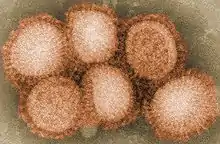Goose Guangdong virus
The Goose Guangdong virus refers to the strain A/Goose/Guangdong/1/96 (Gs/Gd)-like H5N1 HPAI viruses. It is a strain of the Influenzavirus A subtype H5N1 virus that was first detected in a goose in Guangdong in 1996. It is an HPAI (High Pathogenic Avian Influenza) virus, meaning that it can kill a very high percentage of chickens in a flock in mere days. It is believed to be the immediate precursor of the current dominant strain of HPAI A(H5N1) that evolved from 1999 to 2002 creating the Z genotype (also called "Asian lineage HPAI A(H5N1)") that is spreading globally and is epizootic (an epidemic in nonhumans) and panzootic (affecting animals of many species, especially over a wide area), killing tens of millions of birds and spurring the culling of hundreds of millions of others to stem its spread.[1][2][3][4][5][6][7]
| Goose Guangdong virus | |
|---|---|
| Virus classification | |
| (unranked): | Virus |
| Realm: | Riboviria |
| Kingdom: | Orthornavirae |
| Phylum: | Negarnaviricota |
| Class: | Insthoviricetes |
| Order: | Articulavirales |
| Family: | Orthomyxoviridae |
| Genus: | Alphainfluenzavirus |
| Species: | |
| Strain: | Goose Guangdong virus |
| Influenza (flu) |
|---|
 |
 |
The conversion to the Z genotype probably occurred by reassortment with a teal (duck) virus H6N1 during a mixed influenza infection:
- "An H6N1 virus isolated from teal (A/teal/Hong Kong/W312/97 [H6N1]) showed very high (>98%) nucleotide homology to the human influenza virus A/Hong Kong/156/97 (H5N1) in the six internal genes. The N1 neuraminidase sequence showed 97% nucleotide homology to that of the human H5N1 virus, and the N1 protein of both viruses had the same 19-amino-acid deletion in the stalk region. The deduced hemagglutinin amino acid sequence of the H6N1 virus was most similar to that of A/shearwater/Australia/1/72 (H6N5). The H6N1 virus is the first known isolate with seven H5N1-like segments and may have been the donor of the neuraminidase and the internal genes of the H5N1 viruses. The high homology between the internal genes of H9N2, H6N1, and the H5N1 isolates indicates that these subtypes are able to exchange their internal genes and are therefore a potential source of new pathogenic influenza virus strains."[8]
See also
Sources and notes
- lib.bioinfo.pl Archived 2008-01-08 at the Wayback Machine article Characterization of low pathogenic H5 subtype influenza viruses from Eurasia: Implications for the origin of highly pathogenic H5N1 viruses. published J Virol. 2007 May 16; : 17507485 says "Highly pathogenic avian influenza (HPAI) H5N1 viruses are now endemic in many Asian countries, resulting in repeated outbreaks in poultry and increased cases of human infection. The immediate precursor of these HPAI viruses is believed to be A/Goose/Guangdong/1/96 (Gs/Gd)-like H5N1 HPAI viruses first detected in Guangdong in 1996."
- Chapter Two : Avian Influenza by Timm C. Harder and Ortrud Werner Archived 2016-05-10 at the Wayback Machine in Influenza Report 2006
- Large-scale sequencing of human influenza reveals the dynamic nature of viral genome evolution Nature magazine presents a summary of what has been discovered in the Influenza Genome Sequencing Project.
- Avian Influenza A (H5N1) Infection in Humans by The Writing Committee of the World Health Organization (WHO) Consultation on Human Influenza A/H5 in the September 29, 2005 New England Journal of Medicine
- The Threat of Pandemic Influenza: Are We Ready? Workshop Summary (2005) Archived 2006-09-14 at the Wayback Machine Full text of online book by INSTITUTE OF MEDICINE OF THE NATIONAL ACADEMIES
- CDC has a phylogenetic tree showing the relationship between dozens of highly pathogenic varieties of the Z genotype of avian flu virus H5N1 and ancestral strains.
- "Evolutionary characterization of the six internal genes of H5N1 human influenza A virus". Archived from the original on 2007-12-19. Retrieved 2007-12-25.
- Journal of Virology, July 2000, p. 6309-6315, Vol. 74, No. 14 article Characterization of the Influenza A Virus Gene Pool in Avian Species in Southern China: Was H6N1 a Derivative or a Precursor of H5N1?
Further reading
- Journal of Virology, January 2002, p. 507-516, Vol. 76, No. 2 article Molecular Evolution of H6 Influenza Viruses from Poultry in Southeastern China: Prevalence of H6N1 Influenza Viruses Possessing Seven A/Hong Kong/156/97 (H5N1)-Like Genes in Poultry